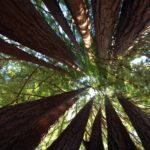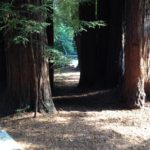I recently spent some time in a redwood forest in California. There was a particular grove of trees arranged in a near perfect circle and a clearly defined space to enter, which cried out to do something sacred with it. I spent the weekend experimenting with various rituals surrounding it.
The ideas that first occurred to me were not obviously better than “just lie in the center of the grove together, look up and meditate, and then quietly whisper whatever thoughts came to your mind for a while.” So I started with that, and gradually added and removed things. (When all is said an done, this is a pretty solid Minimum Viable Ritual which may in some ways be better than anything more elaborate).
By the end of the weekend I hit something close to a local maxima – perhaps not the best possible direction for a redwood ritual, but pretty decent. I was looking for something that actively reconciled two worldviews – the notion that the natural world is often beautiful and valuable, and “technological optimism” – the notion that technology has and can continue to make the world safer and more valuable, even if that technology has risks and if it involves taking apart the natural world to make other things we care about.
Material Components:
- A grove of redwood trees. Ideally, a smallish clearly delineated circle of them, but the most important element is that it’s secluded and beautiful and you can reliably not be bothered while inside.
- You and a smallish number of friends (upper bound depends on how big your favorite grove of redwood trees is)
- Ideally, all you have memorized the words to the songs “Time wrote the rocks” and “Dust in the Wind”, and the poem “Ozymandias” (lyrics included below). If at least two of you have them partially memorized you can help each other remember in the moment. [Note: I couldn’t help myself but add a single word to “Dust in the Wind” that changes a line from not making sense at all to being totally fine.
The exact best poems and songs to do may vary by group of people – these were ones that I had some connection with and are meaningful to me, and tie together in a particular way. (I’ve looked around a bit for specific poems about Redwoods but they were almost too on-the-nose).
But I think it is important that whichever ones you do, people have at least made an effort to memorize and gain a deep understanding of – even if they do not succeed in memorizing, the process can help you become the poem in a deeper way, and you can spend the ceremony soaking them in rather than trying to interpret them in realtime, which I often find difficult.
Part I: The Approach
Approach the grove silently, and then circle around it three times, letting your mind clear and taking in an overall sense of the trees.
Stop by the entrance to the grove. Take off your shoes.
Take three deep breaths together
Enter the Grove
Walk around the inside of the grove once, taking in a sense of the roots.
Clear away uncomfortable debris in the inside of the grove, lie down with your heads in the center of the grove (heads slightly touching each other), and your bare feet on the trunks of the trees.
Quietly meditate for a few minutes, staring up at the immense ancient living things before you.
Part II: Reflections
Reflect – perhaps to yourself privately, perhaps in hushed whispers to each other:
- Reflect on how much better than you are the Redwoods are at being tall, at touching the sunlight, and at living for thousands of years. For a moment, without thinking too much about it, simply appreciate the subtle dapples of sunlight, the smell of cedar, the rustle of wind.
- Reflect upon the subtle changes within the grove, over timescales you can notice if you slow yourself down to perceive them. How leaves slowly will drift down from time to time. How the trees are not statues – they may bend in the breeze, groaning and creaking. How the sun is not a fixed point in the sky – it will shift over a couple minutes, so that where one minute it glowed softly behind branches and another it steps out to shine in your eyes. (Perhaps shift your head to be more comfortable afterwards, but not before taking a moment to close them, relax and feel the warmth against your face)
- Reflect upon the painstaking eons of living entities that died, and the feedback loops by which their slightly different siblings and cousins who lived slowly took new shape. Some of them one day became these ancient redwood trees. Some of them became you. Reflect upon timescales we can never perceive directly no matter how we slow ourselves down, but which we can nonetheless find evidence of – the patient stone which speaks if we but listen when it talks.
- Reflect upon the legions of Redwood Trees that once stood in California. The thousands of years it took them to grow. The century it took for humans to cut them down and turn them into something new.
- Reflect on feedback loops that happen more slowly than the ones which drive human civilization, which may sometimes be hard to detect and respond to.
- Reflect upon the people who saw the last remaining redwoods and moved to preserve them.
- Reflect upon opportunity costs – both of the trees that cut down, and the ones which remain. There are forests no longer standing for people to appreciate and for animals to live in – but there are also houses that could be built more cheaply, homes for people who might have had trouble affording them otherwise. The children who played and grew and learned in them. Necklaces, tools and schools carved from the wood. Couples in love who inscribed their name upon trunks.In time, perhaps come to some conclusion (or temporary understanding) on how to balance the value of nature – both wild and tamed, against the value of the things humans build from it. But come to those conclusions with a clear understanding of all sides of the equation.
- Reflect upon the timescale on which things eventually die:The single redwood that once stood at the center of the grove, which is now gone – the only evidence of its existence to you in this moment being the genetically identical children that grew from its remains.The humans born and buried, empires rising and falling, during the time it took the grove to grow.
The eventual day when the grove will be gone, when it will take cleverness and deep study to find evidence of its existence at all.
The eventual moment, one day, where there might be no evidence at all that the grove, or humanity, or the earth ever existed.
Part III: Soft Music and Poetry
Begin to breath more deeply, and eventually to hum together – slowly, but gradually improvising harmonies and flourishes.
As the group hums, one by one, take turns reciting a stanza of lyrics from “Time Wrote the Rocks”. (Originally “The Word of God”, by Catherine Faber). This can either be sung, or spoken as poetry). On the last (bolded) line of each section, everyone speaks together. Then, begins humming again before the next section starts.
From desert cliff and mountain top, we trace the wide design.
Strike-slip fault and overthrust and syn and anticline.
We gaze upon creation where erosion makes it known,
And count the countless eons in the banding of the stone.
Odd long vanished creatures and their tracks and shells are found,
Where truth has left its sketches on the slate beneath the ground.
The patient can speak if we but listen when it talks.
Humans wrote the book of earth…
…time wrote the rocks.
There are those who name the stars, who watch the sky by night.
Seeking out the darkest place, to better see the light.
Long ago when isolation broke his weary will,
Galileo recanted, but the earth is moving still.
High above the mountaintops where only distance bars,
The truth has left its footprints in the dust between the stars.
We can watch and study, or may shudder and deny.
Humans wrote the book of night…
…light wrote the sky.
By stem and root and branch we trace, by feather, fang and fur.
How the living things that are descend from things that were.
The moss, the kelp, the zebra fish, the very mice and flies.
Tiny, humble wordless things how shall they tell us lies.
We are kin to beast, no other answer can we bring.
The truth has left its fingerprints on every living thing.
Winnowed by an aimless game of birth and blood and strife…
Humans wrote the books of names…
…death wrote life.
And we who listen to the stars, or walk the dusty grade
Or break the very atoms down to see how they are made.
Who seek knew stories, seek to song to better guide our hand…
The profoundest act of worship is to try to understand.
Deep in flower and in flesh, in star and soil and seed
The truth has left its living word for anyone to read.
So turn and look where best you think the story is unfurled.
Humans write the book of truth…
…truth writes the world.
Continue humming. Over time, add complexity the humming as you begin to sing a wordless, improvised “instrumental” backdrop to Dust in the Wind – a song about entropy, and the default state of the future. Sing together, although some may continue humming instrumental parts while others sing the lyrics.
I close my eyes, only for a moment, then the moment’s gone.
All my dreams… pass before my eyes a curiosity.
Dust in the wind… …all we are is dust in the wind.
Same old song… just a drop of water in an endless sea.
All we do… crumbles to the ground though we refuse to see.
Dust in the wind… …all we are is dust in the wind.
Don’t hang on… nothing lasts forever but the earth and sky.
Slips away… and all your money won’t another minute buy.
Dust in the wind… …all we are is dust in the wind.
Dust in the wind… …all we are is dust in the wind.
Allow the humming to die down. And then whisper together the poem of Ozymandias:
I met a traveller from an antique land,
Who said: “Two vast and trunkless legs of stone
Stand in the desert… near them, on the sand
Half sunk a shattered visage lies, whose frown,
And wrinkled lip, and sneer of cold command,
Tell that its sculptor well those passions read
Which yet survive, stamped on these lifeless things,
The hand that mocked them, and the heart that fed;
And on the pedestal, these words appear:
My name is Ozymandias, King of Kings;
Look upon my Works, ye Mighty, and despair!
Nothing beside remains. Round the decay
Of that colossal Wreck, boundless and bare.
The lone and level sands stretch far away.”
Part IV: Departure
Take seven deep breaths together.
Slowly stand upon when it feels right. Turn to each other and brush off the dirt and debris from each other’s backs and hair.
Brush the debris on the ground back into a state that doesn’t leave obvious evidence that humans had cleared a space for themselves.
Stand in a circle, arms around each other. Look into each others eyes. Look up to the trees together.
Take one last deep breath, then depart the circle of trees. Put your shoes back on. Begin to walk away. Do not speak until you can no longer see the circle of trees.


